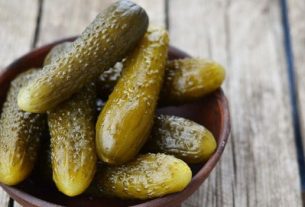Step into the world of sausages, where flavors and traditions collide.
In the gustatory ring, two contenders stand tall: braunschweiger and liverwurst.
These beloved sausages tantalize taste buds with their porky goodness, but their distinct ingredients, recipes, and cooking methods create a delightful battle of flavors.
Join us as we delve into the realms of these savory treats and uncover the secrets behind braunschweiger versus liverwurst.
braunschweiger vs liverwurst
Braunschweiger and liverwurst are both types of sausages made from pork, beef, or a mixture of both.
The main differences between them lie in the meats used, additional ingredients, and cooking methods.
Braunschweiger typically contains at least 30% liver and additional spices, while liverwurst is made from a mixture of meat, animal fat, liver, and spices, and may include other organs.
Braunschweiger can be smoked or boiled, whereas liverwurst is traditionally boiled.
Both sausages can be spread on bread or crackers and used in various recipes.
Key Points:
- Braunschweiger and liverwurst are both sausages made from pork, beef, or a mixture of both.
- Braunschweiger typically contains at least 30% liver and additional spices, while liverwurst is made from a mixture of meat, animal fat, liver, and spices, and may include other organs.
- The cooking methods for Braunschweiger include smoking or boiling, whereas liverwurst is traditionally boiled.
- Both sausages can be spread on bread or crackers and used in various recipes.
- The main differences between the sausages lie in the meats used and additional ingredients.
- Liverwurst is made from a mixture of meat, animal fat, liver, and spices, while Braunschweiger contains at least 30% liver and additional spices.
braunschweiger vs liverwurst – Watch Video


Pro Tips:
1. The name “Braunschweiger” comes from the German city of Braunschweig, which is where this type of liver sausage originated. On the other hand, “liverwurst” is an English term derived from the German “Leberwurst,” meaning liver sausage.
2. Despite both being liver sausages, the main difference between Braunschweiger and liverwurst lies in the ingredients used. Braunschweiger is often made with pork liver, while liverwurst can be made with a combination of pork, beef, and even veal liver.
3. While they may look similar, Braunschweiger and liverwurst have distinct flavors. Braunschweiger typically has a stronger taste and a smoother texture compared to liverwurst, which is milder and often has a coarser consistency.
4. In terms of popularity, Braunschweiger is more commonly consumed in the United States, especially in the Midwest, where it’s considered a staple. Liverwurst, on the other hand, enjoys a broader popularity across Europe, particularly in Germany, where it is commonly used in sandwiches.
5. Both braunschweiger and liverwurst are often enjoyed as spreadable sausages on bread or crackers, but they also have versatile culinary uses. For instance, Braunschweiger can be incorporated in various recipes, including dips, pâtés, and even meatloaf. Liverwurst, on the other hand, can be sliced and used as a sandwich filling or even pan-fried until crispy and served with eggs.
1. Introduction: Braunschweiger Vs Liverwurst
Deli meats hold a special place in the hearts of food enthusiasts, and Braunschweiger and liverwurst are two beloved sausages that grace the deli counter with their rich and savory flavors. These sausages, crafted from a combination of pork, beef, or both, are known for their distinctive taste and versatility.
While they may appear similar at first glance, closer examination reveals the unique characteristics that set Braunschweiger and liverwurst apart. In this article, we delve into the ingredients, recipes, cooking methods, and uses of these delectable deli meats, and explore the main differences that make each sausage a splendid choice for any culinary adventure.
2. Ingredients And Recipes For Braunschweiger
Braunschweiger, a sausage originating from Germany, boasts a rich and flavorful profile that makes it a favorite amongst deli enthusiasts. The key component of Braunschweiger is liver, which accounts for at least 30% of its total ingredients. Additionally, this succulent sausage is seasoned with a tantalizing blend of spices, including pepper, garlic, nutmeg, ginger, cardamom, and onion powder. The combination of these spices imparts a robust and aromatic flavor to the final product.
When it comes to recipes featuring Braunschweiger, the possibilities are nearly endless. One can spread it on a hearty slice of bread or a delicate cracker, allowing the luscious flavors to dance upon the palate. For those seeking a more elaborate culinary adventure, incorporating Braunschweiger into dishes like grilled cheese sandwiches or baked casseroles adds a delightful twist to familiar classics.
3. Ingredients And Recipes For Liverwurst
Liverwurst and its counterpart Braunschweiger are sausages that combine meats and spices to create a deeply satisfying flavor. This deli meat typically includes pork, beef, animal fat, liver, and various spices. Some variations may also include other organs like the heart and kidney, adding to its rich taste.
Liverwurst is incredibly versatile in the culinary world. It can be spread on bread or crackers, adding a savory touch to salads or omelets. Its smooth and creamy texture allows for endless possibilities in recipes. Whether you’re looking for a quick snack or inspiration for a gourmet dish, liverwurst is sure to please.
4. The Making Of Liverwurst
Crafting liverwurst is an art form that requires skill and precision. The process begins with combining a carefully selected mixture of pork, beef, animal fat, liver, and spices. These ingredients are then finely ground to achieve the desired consistency. After the blending process, the mixture is carefully cooked by boiling, allowing the flavors to meld together and creating the distinct, melt-in-your-mouth texture that liverwurst is known for.
5. The Making Of Braunschweiger
Creating the enticing flavors of Braunschweiger follows a similar process to that of liverwurst. The combination of pork, beef, liver, and spices is skillfully ground to achieve a smooth and delectable texture. Unlike liverwurst, however, Braunschweiger has the option of being smoked or boiled. The smoking process enhances the flavor by imparting a subtle smokiness to the sausage, adding yet another layer of complexity to its taste. The choice between smoked or boiled Braunschweiger ultimately depends on personal preference and desired flavor profiles.
6. Smoking Vs Boiling: Cooking Methods For Braunschweiger
One of the distinct characteristics that differentiate Braunschweiger from liverwurst is the cooking method. Braunschweiger can be prepared through two primary techniques: smoking or boiling. Smoking involves exposing the sausage to varying levels of heat and indirect smoke, resulting in a more intense and nuanced flavor profile. On the other hand, boiling Braunschweiger yields a milder taste, ensuring that the delicate balance between the ingredients is preserved. The choice between smoking and boiling rests in the hands of those seeking to savor the varied and enticing dimensions of this remarkable deli sausage.
7. Traditional Boiling: Cooking Method For Liverwurst
Liverwurst is traditionally prepared through boiling to ensure that the flavors meld together, resulting in a soft, smooth, and utterly delectable sausage. Boiling allows the liverwurst to retain its natural moisture, resulting in a texture that effortlessly melts in your mouth. The traditional approach to cooking liverwurst celebrates the simplicity of the ingredients and the skill of the craftsman, resulting in a final product that is both comforting and indulgent.
- Liverwurst is traditionally boiled to meld flavors and create a soft texture.
- Boiling retains the sausage’s natural moisture, resulting in a melt-in-your-mouth experience.
- The traditional approach to cooking liverwurst emphasizes simplicity and craftsmanship.
“Liverwurst, in contrast to Braunschweiger, is traditionally prepared through boiling.”
8. Versatile Uses: Bread, Crackers, And Recipes
Both Braunschweiger and liverwurst excel in their ability to be enjoyed in a variety of ways. The creamy and savory nature of these sausages makes them ideal for spreading on bread or crackers, creating a delightful and satisfying snack. Their versatility extends beyond the realm of simple spreads, offering endless possibilities for culinary experimentation. From adding a luxurious layer to sandwiches to enhancing the flavors of hearty soups or stews, Braunschweiger and liverwurst serve as the perfect secret ingredient in countless recipes.
- Ideal for spreading on bread or crackers
- Versatile ingredient for culinary experimentation
- Adds a luxurious layer to sandwiches
- Enhances flavors of soups or stews
“Braunschweiger and liverwurst are the perfect secret ingredients in countless recipes.”
9. Main Differences: Meats, Ingredients, And Cooking Methods
While there are similarities between Braunschweiger and liverwurst, it is the differences that distinguish them in the world of deli meats. The main distinction lies in the types of meats used. Braunschweiger prominently features liver, while liverwurst is a blend of pork, beef, and liver.
Furthermore, the additional ingredients and seasoning contribute to their unique flavors. Braunschweiger incorporates spices such as pepper, garlic, nutmeg, ginger, cardamom, and onion powder, which adds depth to its taste. On the other hand, liverwurst follows a more traditional approach, with a simple blend of spices.
In terms of cooking methods, Braunschweiger offers the option of smoking or boiling, giving it a smoky and rich flavor. In contrast, liverwurst follows a traditional boiling technique, resulting in a more straightforward taste.
To summarize:
- Braunschweiger prominently features liver, while liverwurst is a blend of pork, beef, and liver.
- Braunschweiger incorporates spices such as pepper, garlic, nutmeg, ginger, cardamom, and onion powder, adding depth to its taste.
- Braunschweiger can be smoked or boiled, while liverwurst is traditionally boiled.
10. Conclusion: Choosing Between Braunschweiger And Liverwurst
Ultimately, the decision between Braunschweiger and liverwurst hinges on personal preference and desired flavor profiles. Braunschweiger, with its higher liver content and additional spices, offers a robust and aromatic experience, whether smoked or boiled. On the other hand, liverwurst presents a smooth and creamy alternative, emphasizing the harmonious blend of meats and traditional boiling method. Whichever sausage you choose, the palatable world of deli meats awaits, ready to tantalize your taste buds with its rich, savory flavors and endless culinary possibilities. Bon appétit!

You may need to know these questions about braunschweiger vs liverwurst
How do Germans eat braunschweiger?
In Germany, braunschweiger is commonly enjoyed by first slicing the sausage into smaller pieces and then frying it with smoked meat, like bacon, until it obtains a delightful browned hue. Served as a main meal, this delectable dish is frequently paired with mashed potatoes, vegetables, or pasta. Germans relish the combination of flavors and textures resulting from the crispy and savory braunschweiger combined with the smoky aroma of the fried meat, creating a satisfying meal that is rich in taste and tradition.
Is liverwurst a healthy meat?
Liverwurst can indeed be considered a healthy meat option due to its rich nutritional profile. This delightful sausage offers a variety of essential nutrients such as healthy fats, amino acids, minerals, and vitamins like Vitamin A and B12. Moreover, liverwurst’s offal nature provides significant amounts of iron, magnesium, selenium, and zinc, further enhancing its nutritional value. Incorporating liverwurst into a balanced diet can contribute to supporting overall health and well-being.
Does liverwurst have liver in it?
Yes, liverwurst does contain liver as one of its main ingredients. Typically made with pigs’ or calves’ liver, liverwurst also includes meat, such as veal, along with fat and a blend of spices including ground black pepper, marjoram, allspice, thyme, ground mustard seed, and nutmeg. Germany, known for its diverse culinary traditions, boasts various regional recipes for liverwurst, each offering its own distinct flavor and character.
Is braunschweiger Raw?
No, braunschweiger is not raw. It is a cooked sausage made from a combination of fresh, cured, and/or frozen pork, beef, and/or veal livers, along with pork and/or beef fat. The sausages are prepared through a cooking process, ensuring they are fully cooked and ready to be consumed.
Reference source
https://discover.grasslandbeef.com/blog/what-is-braunschweiger/
https://www.tasteatlas.com/braunschweiger
https://discover.grasslandbeef.com/blog/liverwurst-nutrition/
https://en.wikipedia.org/wiki/Liverwurst



